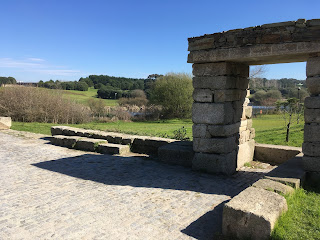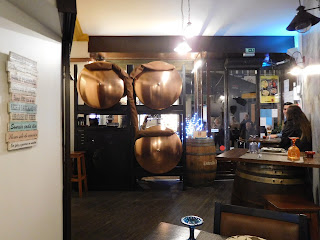I've prefaced the travel narrative of our visit to Portugal (which has been backdated) with a series called Focus on Portugal, which provides background on a European destination that's scandalously little known to Americans. Previously: "Portugal Trip 2018 (7): An epic stroll along the Douro to lunch at São Pedro da Afurada."
Porto's Cemitério de Agramonte was established in 1855 to bury victims of a cholera outbreak, and since then it has become perhaps the city's most prestigious resting place.
The cemetery lies north of the Douro River, just off the Praça Mouzinho de Albuquerque, which is Porto's quasi-equivalent of Monument Circle in Indianapolis, accounting for its other name, the Rotunda da Boavista -- to Southern Indiana residents, one of those detested, mind-boggling, deadly roundabouts.
Cemitério de Agramonte is tidy and well-maintained, with more garbage cans in a typical 20-square-yard area than can be found in some entire New Albany neighborhoods.
Our survey of the burial ground came after we'd eaten lunch at a stellar family-owned neighborhood eatery called Casa Beira Alta, located on Rua da Meditação, the short street that leads from the circle to the cemetery. As you'd expect, the Portuguese word "meditação" means meditation.
The street also boasts at least four floral shops, a grave marker/stone carving workshop and a hotel (for the living).
After coffee, a stroll through the park-like city of the dead was informative and thought-provoking. We usually try to wander a cemetery at least once during every trip abroad. While there are broad similarities, cultures and nations remain different in ways both great and small. Life is fleeting, and even more so, perspective; all the more reason to enter and exit using Meditation Street.
---
The day had started with coffee, pastries and a morning bus ride from the Ribeira west, then north, hugging the right bank of the Douro until the mouth of the river sends traffic on a sharp right-hand turn to follow the Atlantic shoreline to beaches clustered around the Castelo do Queijo, a 17th-century coastal fort.
The vicinity is known as the Foz do Douro. Hopping from the double-decker, we immediately glimpsed public art modernity.
The sculpture by Janet Echelman is called She Changes (locals refer to it as Anémona).
(It) is designed to reflect Porto's and Matosinhos's seafaring and industrial heritage. The three support poles are painted to resemble the smokestacks and lighthouses in the area. The net structure is meant to reference the city's fishing industry.
We decided to investigate Parque da Cidade do Porto, a large green space to the east. In fact, it is Porto's largest public park, and proved to be a delightful and quiet springtime walk.
The park's eastern entrance is at Avenida da Boavista, where the bus lines took us to lunch and the cemetery.
After the obligatory mid-afternoon siesta, a light evening meal seemed merited. Previously we'd dropped into Bodeguita Restaurante Espanhol on Rua Flores near our hotel, a broadly Spanish-themed tapas bar specializing in beer from the Estrella de Galicia brewery in A Coruña. It also serves Portuguese entrees.
When first viewing the storefront, what caught my eye were these tanks. My first thought was cider, but according to our server, who explained that he'd been working there for only a short time, the tanks are fermenters.
His story went something like this: Estrella Galicia partners with a select number of pubs, where wort is brought to be fermented, then is dispensed via the tap on the left.
I seriously doubt that fermentation is taking place; it probably was lost in translation, but I believe fresh unfiltered lager is being brought to these serving vessels, in the vein of Pilsner Urquell's tank lager project, which I'd dearly love to emulate in New Albany.
*Freshly brewed Tank Pilsner Urquell*
...is distributed and delivered unpasteurised directly from the city of Pilsen located in the Czech Republic. Tank Pilsner Urquell is brewed only in the Czech Republic, and is believed to be under state and govermental protection. Tank Pilsner Urquell is always served by the most experienced and professionally trained stuff.
The serving tank/house beer was good, although the 1906 -- ostensibly a Vienna-style lager -- was better.
What's not to love about a city with humongous jugs of ruby and tawny sitting there on the bar top, beguiling and enticing you?
Nothing, I tell you. Nothing.
Next: All things must pass, in this instance with hills, an ocean sunset and a return to the 7 Wonders pub.




































No comments:
Post a Comment